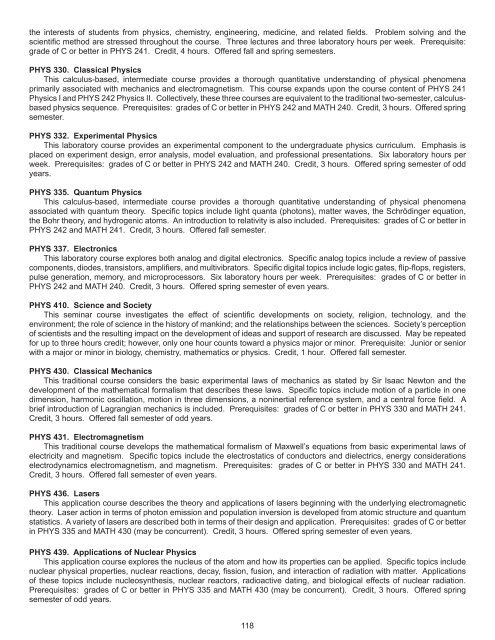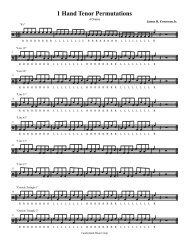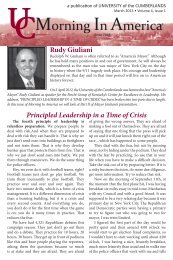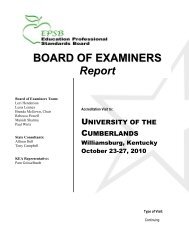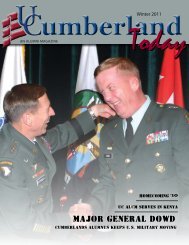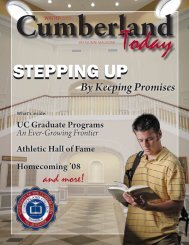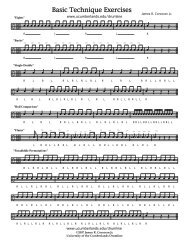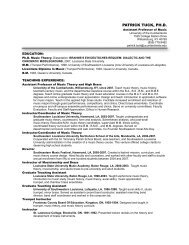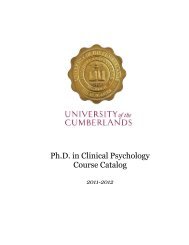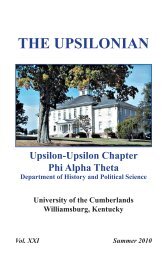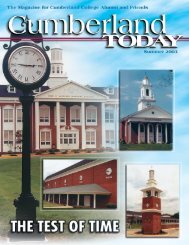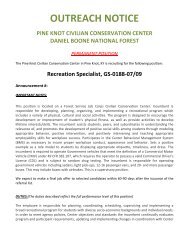2013â2014 Undergraduate Catalog - University of the Cumberlands
2013â2014 Undergraduate Catalog - University of the Cumberlands
2013â2014 Undergraduate Catalog - University of the Cumberlands
You also want an ePaper? Increase the reach of your titles
YUMPU automatically turns print PDFs into web optimized ePapers that Google loves.
<strong>the</strong> interests <strong>of</strong> students from physics, chemistry, engineering, medicine, and related fields. Problem solving and <strong>the</strong><br />
scientific method are stressed throughout <strong>the</strong> course. Three lectures and three laboratory hours per week. Prerequisite:<br />
grade <strong>of</strong> C or better in PHYS 241. Credit, 4 hours. Offered fall and spring semesters.<br />
PHYS 330. Classical Physics<br />
This calculus-based, intermediate course provides a thorough quantitative understanding <strong>of</strong> physical phenomena<br />
primarily associated with mechanics and electromagnetism. This course expands upon <strong>the</strong> course content <strong>of</strong> PHYS 241<br />
Physics I and PHYS 242 Physics II. Collectively, <strong>the</strong>se three courses are equivalent to <strong>the</strong> traditional two-semester, calculusbased<br />
physics sequence. Prerequisites: grades <strong>of</strong> C or better in PHYS 242 and MATH 240. Credit, 3 hours. Offered spring<br />
semester.<br />
PHYS 332. Experimental Physics<br />
This laboratory course provides an experimental component to <strong>the</strong> undergraduate physics curriculum. Emphasis is<br />
placed on experiment design, error analysis, model evaluation, and pr<strong>of</strong>essional presentations. Six laboratory hours per<br />
week. Prerequisites: grades <strong>of</strong> C or better in PHYS 242 and MATH 240. Credit, 3 hours. Offered spring semester <strong>of</strong> odd<br />
years.<br />
PHYS 335. Quantum Physics<br />
This calculus-based, intermediate course provides a thorough quantitative understanding <strong>of</strong> physical phenomena<br />
associated with quantum <strong>the</strong>ory. Specific topics include light quanta (photons), matter waves, <strong>the</strong> Schrödinger equation,<br />
<strong>the</strong> Bohr <strong>the</strong>ory, and hydrogenic atoms. An introduction to relativity is also included. Prerequisites: grades <strong>of</strong> C or better in<br />
PHYS 242 and MATH 241. Credit, 3 hours. Offered fall semester.<br />
PHYS 337. Electronics<br />
This laboratory course explores both analog and digital electronics. Specific analog topics include a review <strong>of</strong> passive<br />
components, diodes, transistors, amplifiers, and multivibrators. Specific digital topics include logic gates, flip-flops, registers,<br />
pulse generation, memory, and microprocessors. Six laboratory hours per week. Prerequisites: grades <strong>of</strong> C or better in<br />
PHYS 242 and MATH 240. Credit, 3 hours. Offered spring semester <strong>of</strong> even years.<br />
PHYS 410. Science and Society<br />
This seminar course investigates <strong>the</strong> effect <strong>of</strong> scientific developments on society, religion, technology, and <strong>the</strong><br />
environment; <strong>the</strong> role <strong>of</strong> science in <strong>the</strong> history <strong>of</strong> mankind; and <strong>the</strong> relationships between <strong>the</strong> sciences. Society’s perception<br />
<strong>of</strong> scientists and <strong>the</strong> resulting impact on <strong>the</strong> development <strong>of</strong> ideas and support <strong>of</strong> research are discussed. May be repeated<br />
for up to three hours credit; however, only one hour counts toward a physics major or minor. Prerequisite: Junior or senior<br />
with a major or minor in biology, chemistry, ma<strong>the</strong>matics or physics. Credit, 1 hour. Offered fall semester.<br />
PHYS 430. Classical Mechanics<br />
This traditional course considers <strong>the</strong> basic experimental laws <strong>of</strong> mechanics as stated by Sir Isaac Newton and <strong>the</strong><br />
development <strong>of</strong> <strong>the</strong> ma<strong>the</strong>matical formalism that describes <strong>the</strong>se laws. Specific topics include motion <strong>of</strong> a particle in one<br />
dimension, harmonic oscillation, motion in three dimensions, a noninertial reference system, and a central force field. A<br />
brief introduction <strong>of</strong> Lagrangian mechanics is included. Prerequisites: grades <strong>of</strong> C or better in PHYS 330 and MATH 241.<br />
Credit, 3 hours. Offered fall semester <strong>of</strong> odd years.<br />
PHYS 431. Electromagnetism<br />
This traditional course develops <strong>the</strong> ma<strong>the</strong>matical formalism <strong>of</strong> Maxwell’s equations from basic experimental laws <strong>of</strong><br />
electricity and magnetism. Specific topics include <strong>the</strong> electrostatics <strong>of</strong> conductors and dielectrics, energy considerations<br />
electrodynamics electromagnetism, and magnetism. Prerequisites: grades <strong>of</strong> C or better in PHYS 330 and MATH 241.<br />
Credit, 3 hours. Offered fall semester <strong>of</strong> even years.<br />
PHYS 436. Lasers<br />
This application course describes <strong>the</strong> <strong>the</strong>ory and applications <strong>of</strong> lasers beginning with <strong>the</strong> underlying electromagnetic<br />
<strong>the</strong>ory. Laser action in terms <strong>of</strong> photon emission and population inversion is developed from atomic structure and quantum<br />
statistics. A variety <strong>of</strong> lasers are described both in terms <strong>of</strong> <strong>the</strong>ir design and application. Prerequisites: grades <strong>of</strong> C or better<br />
in PHYS 335 and MATH 430 (may be concurrent). Credit, 3 hours. Offered spring semester <strong>of</strong> even years.<br />
PHYS 439. Applications <strong>of</strong> Nuclear Physics<br />
This application course explores <strong>the</strong> nucleus <strong>of</strong> <strong>the</strong> atom and how its properties can be applied. Specific topics include<br />
nuclear physical properties, nuclear reactions, decay, fission, fusion, and interaction <strong>of</strong> radiation with matter. Applications<br />
<strong>of</strong> <strong>the</strong>se topics include nucleosyn<strong>the</strong>sis, nuclear reactors, radioactive dating, and biological effects <strong>of</strong> nuclear radiation.<br />
Prerequisites: grades <strong>of</strong> C or better in PHYS 335 and MATH 430 (may be concurrent). Credit, 3 hours. Offered spring<br />
semester <strong>of</strong> odd years.<br />
118


